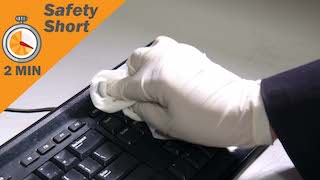

As a family, coronaviruses are common across the globe. This safety short...
MORE INFO </> Embed
</> Embed
As a family, coronaviruses are common across the globe. This safety short outlines some of the control measures that can be taken to prevent their spread.
RUNNING TIME: 2 Minutes
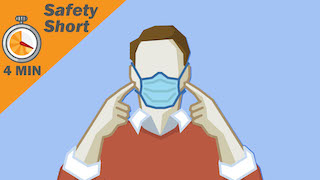

Face Masks are an effective control measure that can be used to control...
MORE INFO </> Embed
</> Embed
Face Masks are an effective control measure that can be used to control the spread of Coronaviruses. This safety short gives a quick overview of common mask types and how to use them correctly.
RUNNING TIME: 4 Minutes
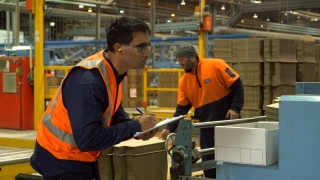

In simple terms a risk assessment requires the identification of workplace...
MORE INFO </> Embed
</> Embed
In simple terms a risk assessment requires the identification of workplace hazards and an evaluation of the risks they present.
The purpose of an overall workplace risk assessment is to establish whether the level of risk arising from workplace activities is acceptable, or whether additional measures need to be taken to control workplace hazards to further reduce or remove unacceptable risks.
The program includes the following Elements of a Risk Assessment:
Regardless of the hazards present, the proper application of the risk assessment process will result in a safer workplace.
RUNNING TIME: 18 minutes
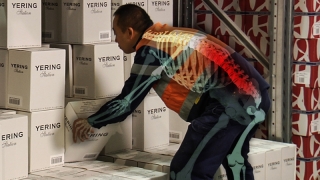

What is manual handling? Simply, manual handling is the movement of items...
MORE INFO </> Embed
</> Embed
Simply, manual handling is the movement of items by human energy.
Manual handling includes lifting, holding, pushing, pulling, shifting and lowering. In fact, any form of human exertion could be included – with or without the use of mechanical aids.
The steps to deal with manual handling can often be addressed by following through a series of questions. This process, the hierarchy of control measures asks the following:
Manual handling contributes directly to a significant percentage of work related accidents and injuries. Manual handling is an issue that must be addressed as an ongoing subject in the workplace.
RUNNING TIME: 12 Minutes
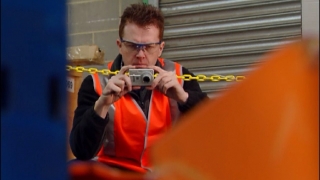

There are laws and regulations that require the investigation and...
MORE INFO </> Embed
</> Embed
There are laws and regulations that require the investigation and reporting of certain types of accidents. Insurance requirements also lead to many Accident Investigations as do potential claims at common law. However, from an Occupational Health & Safety point of view, the main aim of Accident Investigations is not to fulfil these legal and insurance obligations, but rather to prevent recurrences of the same or similar accidents.
Accident Investigations therefore should be regarded as an important part of accident prevention.
This program covers:
Learning why and how accidents occur is fundamental to making improvements in both working conditions and operational methods.
The Accident Investigation process will reduce the number of workplace accidents and should be regarded as an important component of any workplace health and safety strategy.
RUNNING TIME: 12 Minutes


Some workplace hazards are obvious: when there is a risk of physical...
MORE INFO </> Embed
</> Embed
Some workplace hazards are obvious: when there is a risk of physical injury in the workplace, it can be relatively easy to identify and address. But work can also carry risks to mental health.
This program examines the various ways stress can affect members of an organisation as well as potential methods for combatting it.
Topics included in the program:
Work-related stress is not always the easiest of workplace hazards to identify. But being aware of the potential risks, and moving pro-actively to prevent stress taking hold, will help minimise the chances of stress-related illness.
RUNNING TIME: 11 Minutes


Unsafe acts are common contributors to workplace accidents. Behaviour...
MORE INFO </> Embed
</> Embed
Unsafe acts are common contributors to workplace accidents.
Behaviour Based Safety aims at reducing the incidence of unsafe acts by observing tasks, identifying causes of unsafe behavior, and implementing programs to motivate workers to perform safe practices when not being observed.
This program includes:
The program is designed to suit any work environment where a Behaviour Based Safety program is currently being used or where it is being considered.
RUNNING TIME: 15 Minutes


We live in a digital world, and many of the threats that we face, in our...
MORE INFO </> Embed
</> Embed
We live in a digital world, and many of the threats that we face, in our lives and at work, are now digital ones.
Cyber threats are a major issue for organisations, with the possibility of data breaches, financial loss and loss of valuable information.
The most common threats are:
This program will cover the types of cybersecurity threats and how best to identify them.
RUNNING TIME: 10 Minutes


A particularly dangerous form of cybersecurity risk is that of insider...
MORE INFO </> Embed
</> Embed
A particularly dangerous form of cybersecurity risk is that of insider threats.
These are cyber threats that originate from within the organisation which makes them especially difficult to detect and deal with.
Because an insider threat does not need to go through the process of gaining access to the system – as they’re already inside – they are often capable of going undetected for longer, and doing more damage, than external threats.
RUNNING TIME: 3 Minutes


Malware is software created and deployed to compromise or disrupt computer...
MORE INFO </> Embed
</> Embed
Malware is software created and deployed to compromise or disrupt computer systems. The consequences of a system becoming infected with malware can be devastating, including the breakdown of normal operations, the accessing of sensitive information by criminal actors, disruption to business and financial loss.
Any professional computer system should have malware protection set up, but there are also ways in which an individual can identify the possibility of malware, allowing them to take steps to prevent damage.
RUNNING TIME: 2 Minutes


Phishing is a type of social engineering – the practice of manipulating...
MORE INFO </> Embed
</> Embed
Phishing is a type of social engineering – the practice of manipulating people into giving up valuable information.
Signs to look out for to avoid phishing scams include:
RUNNING TIME: 3 Minutes


One specific and very damaging type of malware is ransomware. This is...
MORE INFO </> Embed
</> Embed
One specific and very damaging type of malware is ransomware. This is software that infiltrates a system and stops it working, by locking or encrypting files to prevent access to them. The user of the ransomware will then demand a payment to unlock the system.
RUNNING TIME: 2 Minutes


Passwords are the first line of defence against hackers and scammers. Your...
MORE INFO </> Embed
</> Embed
Passwords are the first line of defence against hackers and scammers.
Your passwords should be strong and unique. Do not use anything that would be easy for someone who knows you to guess as your password. Use a mixture of letters, numbers, and symbols.
Ensure all physical documents and data are securely stored in a desk - preferably locked or appropriately destroyed and disposed of at the end of a work session.
RUNNING TIME: 3 Minutes


Browsing the internet is one of the main sources of danger when it comes to...
MORE INFO </> Embed
</> Embed
Browsing the internet is one of the main sources of danger when it comes to your devices. It is a constant exchange of data through uploading and downloading with the website you are visiting.
When you’re using social media, it’s important to always be aware of what your social media presence might be exposing you to.
Public networks can be a major threat to maintaining digital hygiene as it can leave your devices vulnerable to threats from others connected to the same network.
RUNNING TIME: 4 Minutes


As programs that are not updated are more vulnerable to threats, old and...
MORE INFO </> Embed
</> Embed
As programs that are not updated are more vulnerable to threats, old and unused software and apps should be deleted from your computer or device.
Often software providers will release updates or patches that have been created to address security weaknesses that have recently been identified.
Antivirus and Anti-malware software is also very important for digital systems.
RUNNING TIME: 2 Minutes


Most organisations will have a person, department, or contractor, that is...
MORE INFO </> Embed
</> Embed
Most organisations will have a person, department, or contractor, that is responsible for the management of computers and digital systems in an organisation.
Some of the practical steps outlined in this program may be managed entirely by such a department. Regardless, a basic understanding helps you be a first line of defence for your organisation, and you can apply these learnings when using your personal devices, computers, and systems to help keep yourself safe whenever you’re online.
RUNNING TIME: 2 Minutes


One of the best ways to defend against digital threats like computer...
MORE INFO </> Embed
</> Embed
One of the best ways to defend against digital threats like computer viruses, software bugs, data loss and privacy breaches is through the regular practice of Digital Hygiene.
Digital Hygiene is about learning habits and practices to keep your systems and information secure.
Examples of Digital Hygiene include:
RUNNING TIME: 13 Minutes


It should be the priority of every organisation, and every individual...
MORE INFO </> Embed
</> Embed
It should be the priority of every organisation, and every individual within an organisation, to protect the health and safety of their colleagues and the public, and to ensure their workplace minimises environmental damage, in all its forms.
This program examines how organisations can be aware of their impact on the environment and methods that can be implemented to reduce environmental damage.
Topics included in the program:
Knowing the ways in which your workplace can affect the environment, and staying aware of the ways you can prevent environmental damage from your work, is the first step to creating a more eco-friendly workplace.
RUNNING TIME: 11 Minutes
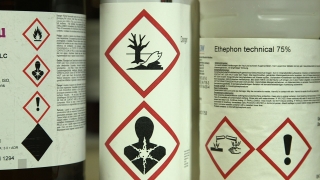

Every year, vast quantities of chemicals are sold and shipped, for use in...
MORE INFO </> Embed
</> Embed
Every year, vast quantities of chemicals are sold and shipped, for use in workplaces around the world.
And, with a global level of trade comes a need to ensure that the hazards pertaining to chemical products are clearly communicated - regardless of where in the world those products are being put to use.
While national laws and regulations relating to chemicals may be similar, they are often different enough to require multiple sets of Labels, Safety Data Sheets, and other information when being traded internationally.
All this creates the potential for confusion - which, when dealing with hazardous chemicals - could have disastrous consequences in the workplace.
Developed at the UN level, the Globally Harmonised System of Classification and Labelling of Chemicals (or GHS for short) aims to develop a single, globally harmonised system to address:
This program provides an overview of these elements as your workplace makes the transition to the GHS.
DURATION: 13 Minutes
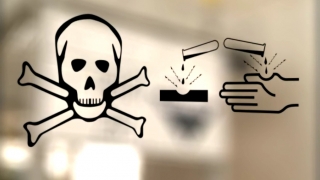

There are literally thousands of different substances used in the...
MORE INFO </> Embed
</> Embed
There are literally thousands of different substances used in the workplace.
Cleaners, adhesives, paints, solvents, pesticides, inks, lubricants and fuels are just some examples. And of course, they come in different forms: powders, granules, solids, liquids and gases.
This program covers:
The objective of this program is to highlight the major hazard areas associated with the use of hazardous substances and by so doing, increase awareness of the standards for worker responsibility in observing and being active in daily safety procedures.
RUNNING TIME: 10 Minutes
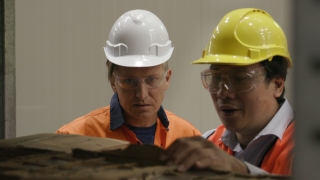

There is human involvement in virtually every accident and incident, however...
MORE INFO </> Embed
</> Embed
There is human involvement in virtually every accident and incident, however in many cases it is not the direct primary cause.
The intention of this program is to examine the human factors involved in accidents, incidents and mistakes in the workplace.
Topics included in the program:
Not all accidents are preventable, but careful forethought and planning, combined with strict adherence to safe work practices will minimise the frequency and severity of accidents and incidents.
RUNNING TIME: 9 Minutes


A Job Safety Analysis, or JSA, is a method for examining a particular job so...
MORE INFO </> Embed
</> Embed
A Job Safety Analysis, or JSA, is a method for examining a particular job so that the hazards and risks can be identified before they occur.
Sometimes referred to as a Job Hazard Analysis, a Job Safety Analysis focuses on all aspects involved in a job. This can include:
If it's a Job Safety and Environmental Analysis, or JSEA, then it will also take into consideration the environmental risks that are present.
RUNNING TIME: 14 Minutes